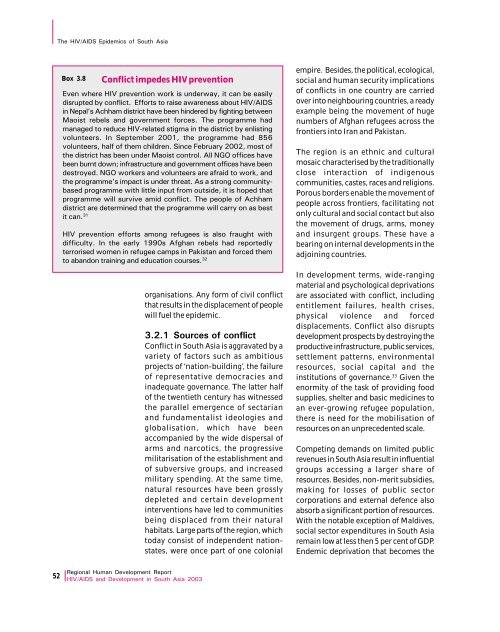Download Report - UNDP Asia-Pacific Regional Centre - United ...
Download Report - UNDP Asia-Pacific Regional Centre - United ...
Download Report - UNDP Asia-Pacific Regional Centre - United ...
You also want an ePaper? Increase the reach of your titles
YUMPU automatically turns print PDFs into web optimized ePapers that Google loves.
The HIV/AIDS Epidemics of South <strong>Asia</strong>Box 3.8Conflict impedes HIV preventionEven where HIV prevention work is underway, it can be easilydisrupted by conflict. Efforts to raise awareness about HIV/AIDSin Nepal’s Achham district have been hindered by fighting betweenMaoist rebels and government forces. The programme hadmanaged to reduce HIV-related stigma in the district by enlistingvolunteers. In September 2001, the programme had 856volunteers, half of them children. Since ebruary 2002, most ofthe district has been under Maoist control. All NGO offices havebeen burnt down; infrastructure and government offices have beendestroyed. NGO workers and volunteers are afraid to work, andthe programme’s impact is under threat. As a strong communitybasedprogramme with little input from outside, it is hoped thatprogramme will survive amid conflict. The people of Achhamdistrict are determined that the programme will carry on as bestit can. 31HIV prevention efforts among refugees is also fraught withdifficulty. In the early 1990s Afghan rebels had reportedlyterrorised women in refugee camps in Pakistan and forced themto abandon training and education courses. 32organisations. Any form of civil conflictthat results in the displacement of peoplewill fuel the epidemic.3.2.1 Sources of conflictConflict in South <strong>Asia</strong> is aggravated by avariety of factors such as ambitiousprojects of ‘nation-building’, the failureof representative democracies andinadequate governance. The latter halfof the twentieth century has witnessedthe parallel emergence of sectarianand fundamentalist ideologies andglobalisation, which have beenaccompanied by the wide dispersal ofarms and narcotics, the progressivemilitarisation of the establishment andof subversive groups, and increasedmilitary spending. At the same time,natural resources have been grosslydepleted and certain developmentinterventions have led to communitiesbeing displaced from their naturalhabitats. Large parts of the region, whichtoday consist of independent nationstates,were once part of one colonialempire. Besides, the political, ecological,social and human security implicationsof conflicts in one country are carriedover into neighbouring countries, a readyexample being the movement of hugenumbers of Afghan refugees across thefrontiers into Iran and Pakistan.The region is an ethnic and culturalmosaic characterised by the traditionallyclose interaction of indigenouscommunities, castes, races and religions.Porous borders enable the movement ofpeople across frontiers, facilitating notonly cultural and social contact but alsothe movement of drugs, arms, moneyand insurgent groups. These have abearing on internal developments in theadjoining countries.In development terms, wide-rangingmaterial and psychological deprivationsare associated with conflict, includingentitlement failures, health crises,physical violence and forceddisplacements. Conflict also disruptsdevelopment prospects by destroying theproductive infrastructure, public services,settlement patterns, environmentalresources, social capital and theinstitutions of governance. 33 Given theenormity of the task of providing foodsupplies, shelter and basic medicines toan ever-growing refugee population,there is need for the mobilisation ofresources on an unprecedented scale.Competing demands on limited publicrevenues in South <strong>Asia</strong> result in influentialgroups accessing a larger share ofresources. Besides, non-merit subsidies,making for losses of public sectorcorporations and external defence alsoabsorb a significant portion of resources.With the notable exception of Maldives,social sector expenditures in South <strong>Asia</strong>remain low at less then 5 per cent of GDP.Endemic deprivation that becomes the52<strong>Regional</strong> Human Development <strong>Report</strong>HIV/AIDS and Development in South <strong>Asia</strong> 2003
















